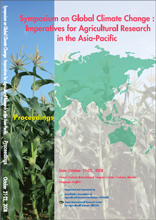Implications of Global Climate Change for Indian Agriculture

Recent IPCC report and several other studies indicate a probability of 10-40% loss in crop
production in India and other countries of South Asia with increases in temperature by 2080-2100 and
decrease in irrigation water. India could lose 4-5 million tons wheat production with every rise of 1oC
temperature throughout the growing period even after considering carbon fertilization (but no
adaptation benefits). The losses would be even higher in case irrigation would decrease in future.
Losses for other crops are still uncertain but they are expected to be smaller, especially for monsoon
season crops. These modeling-based estimates are in line with the recent field observations.
Droughts, floods, tropical cyclones, heavy precipitation events, hot extremes, and heat waves
are known to negatively impact agricultural production, and farmers’ livelihood. The projected
increase in these events will result in greater instability in food production and threaten livelihood
security of farmers. Increased production variability could be perhaps the most significant impact of
global impact change on India. All agricultural commodities even today are sensitive to such
variability.
Early signs of decrease in yields due to changing weather have started becoming visible.
Analysis of the historical trends in yields of crops in the Indo-Gangetic plains using regional statistics,
long-term fertility experiments, other conventional field experiments and crop simulation models has
shown that rice yields during last three decades are showing a declining trend and this may be partly
related to the gradual change in weather conditions during last two decades. Apple yields are showing
a declining trend in lower hills of Himachal Pradesh due to non-fulfilment of chilling requirement
essential for proper flowering and fruiting.
Producing enough food for meeting the increasing demand against the background of reducing
resources in a changing climate scenario, while also minimizing further environmental degradation, is
a challenging task. This would require increased adaptation and mitigation research, capacity building,
changes in policies, regional cooperation, and support of global adaptation and mitigation funds and
other resources. Simple adaptations such as change in planting dates and crop varieties could help in
reducing impacts of climate change to some extent. Losses in wheat production can be reduced from
4-5 million tons to 1-2 million tons if a large percentage of farmers could change to timely planting.
This may, however, not be easy to implement due to constraints associated with wheat planting time in
rice-based cropping systems. Additional strategies for increasing our adaptive capacity include
bridging yield gaps to augment production, development of adverse climate tolerant genotypes and
land use systems, assisting farmers in coping with current climatic risks through providing weather
linked value-added advisory services to farmers and crop/weather insurance, and improved land and
water use management and policies.
| Date of issued | |
|---|---|
| Creator | Pramod K. Aggarwal |
| Subject |
India climate change adaptation crop yields simulation |
| Publisher | Japan International Research Center for Agricultural Sciences |
| Available Online | |
| Issue | 2008 |
| spage | 71 |
| epage | 75 |
| Rights | Japan International Research Center for Agricultural Sciences |
| Language | eng |
